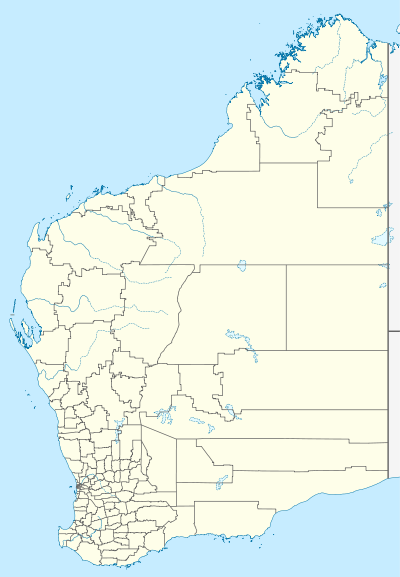Paynes Find, Western Australia
| Paynes Find Western Australia | |||||||
|---|---|---|---|---|---|---|---|
|
Paynes Find c. 1980 | |||||||
 Paynes Find | |||||||
| Coordinates | 29°15′S 117°41′E / 29.250°S 117.683°ECoordinates: 29°15′S 117°41′E / 29.250°S 117.683°E | ||||||
| Population | 77 (2006 census)[1] | ||||||
| Established | 1911 | ||||||
| Postcode(s) | 6612 | ||||||
| Elevation | 339 m (1,112 ft) | ||||||
| Location |
| ||||||
| LGA(s) | Shire of Yalgoo | ||||||
| State electorate(s) | North West | ||||||
| Federal Division(s) | Durack | ||||||
| |||||||
Paynes Find is a former gold rush settlement approximately 430 kilometres (267 mi) northeast of Perth in the Mid West region of Western Australia. It is reachable by the Great Northern Highway. Only a roadhouse, which serves as a fuel stop, and a few other buildings remain today. The area is renowned for its wildflowers.
The townsite was gazetted in 1911, the same year the gold battery was constructed. The battery is the only currently operational battery left in the state.[2]
The town is named after the prospector, Thomas Payne, who was the first to discover gold in the area and was the first to register a lease for gold mining with the Mines Department. He was rewarded with free use of the state's gold battery and his ore was the first to be crushed using the battery. By the 1930s the town had prospered and the population was estimated at about 500. In 1987 the battery was sold to the Taylor family who use it as a tourist attraction.[3]
In popular culture
The character "Dar Dar" in The Numtums was named after Dar Dar Spring near Paynes Find.
References
- ↑ Australian Bureau of Statistics (25 October 2007). "Paynes Find (State Suburb)". 2006 Census QuickStats. Retrieved 2008-09-16.
- ↑ "Australia's Golden Outback". 2008. Retrieved 2008-09-16.
- ↑ "Totaltravel - Paynes Find". 2008. Retrieved 2008-09-16.
External links
![]() Media related to Paynes Find, Western Australia at Wikimedia Commons
Media related to Paynes Find, Western Australia at Wikimedia Commons
- Payne's Find at Tourism Western Australia